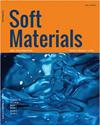通过对接、分子动力学和实验室实验探索II型和III型胶原与短肽苯基吡唑偶联物的结合相互作用
IF 1.4
4区 材料科学
Q4 MATERIALS SCIENCE, MULTIDISCIPLINARY
引用次数: 0
摘要
摘要与细胞外基质成分,特别是各种形式的胶原蛋白的相互作用,对于设计成功的组织工程应用支架至关重要。II型和III型胶原都存在于身体的各种结缔组织中,提供稳定性、伤口愈合,在某些情况下有助于纤维形成。在本研究中,我们设计了具有苯基吡唑部分的短肽偶联物,并检测了它们与II型和III型三螺旋胶原模型的相互作用。通过改变与三种不同肽(SYED、SLKD和SLYD)缀合的苯基吡唑部分来改变疏水基团的数量。分子动力学(MD)和对接研究表明,在大多数情况下,与纯肽相比,与苯基吡唑偶联提高了结合亲和力和稳定性。还进行了计算研究,通过将肽缀合物与II型或III型胶原和硫酸软骨素整合,使用MD模拟来检查稳定支架组件的形成,以模拟支架的形成。作为概念验证,我们使用SPR和CD光谱检查了短肽与II型和III型胶原的结合相互作用,然后合成了两种肽偶联物,并通过逐层组装将它们与II型或III型胶原和硫酸软骨素整合,以开发支架来验证计算结果。AFM成像显示纤维结构的形成。然后在间充质干细胞存在的情况下检查支架的细胞相容性,这表明细胞支架基质的形成,特别是与SLYD偶联物的形成。我们的结果表明,这种肽-吡唑偶联物可以用于设计组织工程应用的支架。本文章由计算机程序翻译,如有差异,请以英文原文为准。
Exploration of type II and III collagen binding interactions with short peptide-phenyl pyrazole conjugates via docking, molecular dynamics and laboratory experiments
ABSTRACT Interaction with components of the extracellular matrix, particularly various forms of collagen, is essential for the design of successful scaffolds for tissue engineering applications. Both Type II and Type III collagen are found in various connective tissues in the body, providing stability, wound healing, and in some cases assisting in fibrillogenesis. In this study, we designed short peptide conjugates with phenyl pyrazole moieties and examined their interactions with Type II and III triple helical collagen models. The number of hydrophobic groups was varied by varying the phenyl pyrazole moieties that were conjugated with three separate peptides (SYED; SLKD and SLYD). Molecular dynamics (MD) and docking studies revealed that in most cases conjugating with phenyl pyrazole improved binding affinity and stability compared to neat peptides. Computational studies were also carried out to examine the formation of stable scaffold assemblies using MD simulations by integrating the peptide conjugates with either Type II or III collagen and chondroitin sulfate, in order to mimic the formation of a scaffold. As a proof of concept, we examined the binding interactions of the short peptides with Type II and III collagen using SPR and CD spectroscopy, and then synthesized two of the peptide conjugates and integrated them with either Type II or Type III collagen and chondroitin sulfate by layer-by-layer assembly to develop scaffolds to validate computational results. AFM imaging showed the formation of fibrillary structures. The cytocompatibility of the scaffolds was then examined in the presence of mesenchymal stem cells, that showed the formation of cell-scaffold matrices particularly with SLYD conjugates. Our results indicate that such peptide-pyrazole conjugates, may be developed for designing scaffolds for tissue engineering applications.
求助全文
通过发布文献求助,成功后即可免费获取论文全文。
去求助
来源期刊

Soft Materials
工程技术-材料科学:综合
CiteScore
2.90
自引率
0.00%
发文量
21
审稿时长
2.2 months
期刊介绍:
Providing a common forum for all soft matter scientists, Soft Materials covers theory, simulation, and experimental research in this rapidly expanding and interdisciplinary field. As soft materials are often at the heart of modern technologies, soft matter science has implications and applications in many areas ranging from biology to engineering.
Unlike many journals which focus primarily on individual classes of materials or particular applications, Soft Materials draw on all physical, chemical, materials science, and biological aspects of soft matter. Featured topics include polymers, biomacromolecules, colloids, membranes, Langmuir-Blodgett films, liquid crystals, granular matter, soft interfaces, complex fluids, surfactants, gels, nanomaterials, self-organization, supramolecular science, molecular recognition, soft glasses, amphiphiles, foams, and active matter.
Truly international in scope, Soft Materials contains original research, invited reviews, in-depth technical tutorials, and book reviews.
 求助内容:
求助内容: 应助结果提醒方式:
应助结果提醒方式:


